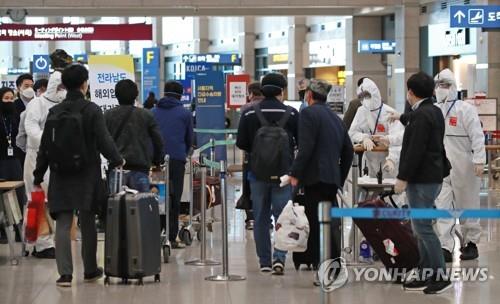- California Assembly OKs highest minimum wage in nation
- S. Korea unveils first graphic cigarette warnings
- US joins with South Korea, Japan in bid to deter North Korea
- LPGA golfer Chun In-gee finally back in action
- S. Korea won’t be top seed in final World Cup qualification round
- US men’s soccer misses 2nd straight Olympics
- US back on track in qualifying with 4-0 win over Guatemala
- High-intensity workout injuries spawn cottage industry
- CDC expands range of Zika mosquitoes into parts of Northeast
- Who knew? ‘The Walking Dead’ is helping families connect
S. Korea’s virus infections top 10,000 as cluster, imported cases rise
South Korea’s coronavirus cases topped 10,000 on Friday amid a slowdown in new infections, but Seoul and the surrounding areas reported a continued rise in virus infections due to a steady rise in mass infections and imported cases.
The 86 new cases of COVID-19, detected Thursday and slightly down from 89 new cases a day earlier, brought the country’s total cases to 10,062 and marked the 22nd consecutive day that new infections have hovered around 100 or fewer additional cases, according to the Korea Centers for Disease Control and Prevention (KCDC).
The total number of confirmed COVID-19 cases has surpassed 10,000 since the coronavirus was first detected in the country on Jan. 20.
The country’s death toll rose by five to 174, with more than half of fatalities being patients aged 80 or older, the KCDC said.
Three more deaths were reported Friday, including a doctor who practiced in the southeastern city of Daegu, but they have not yet been added to the official tally.



A group of South Koreans arrives at Incheon airport, west of Seoul, on April 3, 2020, as they return home from new coronavirus-hit Morocco on a special flight that the North African nation arranged to transport medical items from South Korea. The 105 evacuees will be put under a 14-day isolation. (Yonhap)
A total of 42 additional cases were reported in Seoul and the surrounding region that includes Gyeonggi Province and the western port city of Incheon, bringing the total to 1,119 in the area, it said.
The number of daily new cases in the metropolitan area has continued to increase mainly due to cluster infections at major general hospitals and churches and imported cases.
Seoul reported 18 new cases, bringing the total to 506, partly due to cluster transmission at a church in the Guro district that has emerged as a hot spot of infections in the capital city. At least 37 people from the church have tested positive for the virus.
Gyeonggi Province reported 23 additional COVID-19 cases after a total of 26 people, up five from a day earlier, tested positive for the virus at Uijeongbu St. Mary’s Hospital.
Daegu and North Gyeongsang Province, the nation’s two worst-affected regions, reported nine and five new cases, respectively, the KCDC said. The total number of cases reported in Daegu and the surrounding North Gyeongsang Province reached 6,734 and 1,309, respectively.
It marked the first time in 45 days that Daegu, the epicenter of the outbreak here, had reported a single-digit increase in confirmed cases.
Of the 86 new infections, 38 were imported cases, according to the KCDC. Twenty-two of them were detected at quarantine checkpoints.
The country’s total number of imported cases increased to 647, the KCDC said. Of them, 595 are South Korean nationals and 52 are foreigners.
A total of 5,626 people entered South Korea on Thursday, with more than 70 percent of them South Korean nationals, the KCDC said. It marked the first time the number of entrants was below 6,000.
More than 4,200 South Korean nationals have returned home from 31 countries amid the virus pandemic. About 500 Koreans returned from Italy earlier this week.
Among around 200 returnees from Italy on the second chartered flight Thursday, 20 had symptoms of the virus, with one of them testing positive, the KCDC said.
To stem new coronavirus cases coming from abroad, South Korea has required all arrivals to self-quarantine for two weeks since Wednesday.
Visitors without local addresses are to stay in government-designated facilities at their own expense. All people in isolation must install a mobile app that allows authorities to monitor them in real time and ensure they are following the rules.
“Entrants who test positive for the virus will be transferred to government-designated facilities or hospitals for the treatment and those who test negative will be put under self-isolation for 14 days,” said KCDC Director-General Jeong Eun-kyeong.
Earlier in the day, a local doctor infected with COVID-19 died, marking the first death of a medical worker from the virus.
The 59-year-old medical practitioner in Daegu was confirmed to have the virus on March 19 and had been undergoing treatment at a hospital there, according to the city’s health authorities.
“There should be more studies conducted to determine the exact cause of his death,” Jeong said, adding that he might have contracted the illness while treating a COVID-19 patient at his clinic.
In the face of community spread of the virus, South Korea has been also pushing for an extensive 15-day social distancing campaign since March 22, which ends Sunday.
Citizens are strongly urged to stay home, except for essential needs or jobs. The government has also strongly recommended people suspend religious gatherings, indoor sports activities, and visits to nightclubs and other entertainment venues.
“It is important that people continue to practice intensive social distancing throughout the weekend and avoid gatherings at closed locations,” Yoon Tae-ho, director general for public health policy at the Ministry of Health and Welfare, said in a briefing.
The KCDC also cautioned against public saunas and bathhouses, saying that people should keep a distance from others at the locations.
On Tuesday, the country pushed back the new school year to April 9, with the introduction of online classes. The opening of kindergartens and child care centers has been delayed indefinitely.
The KCDC said 193 more people have fully recovered and been released from quarantine, bringing the total number of cured people to 6,021.
As of Thursday, 3,867 were receiving treatment, down from 3,979 the previous day, according to the KCDC.











